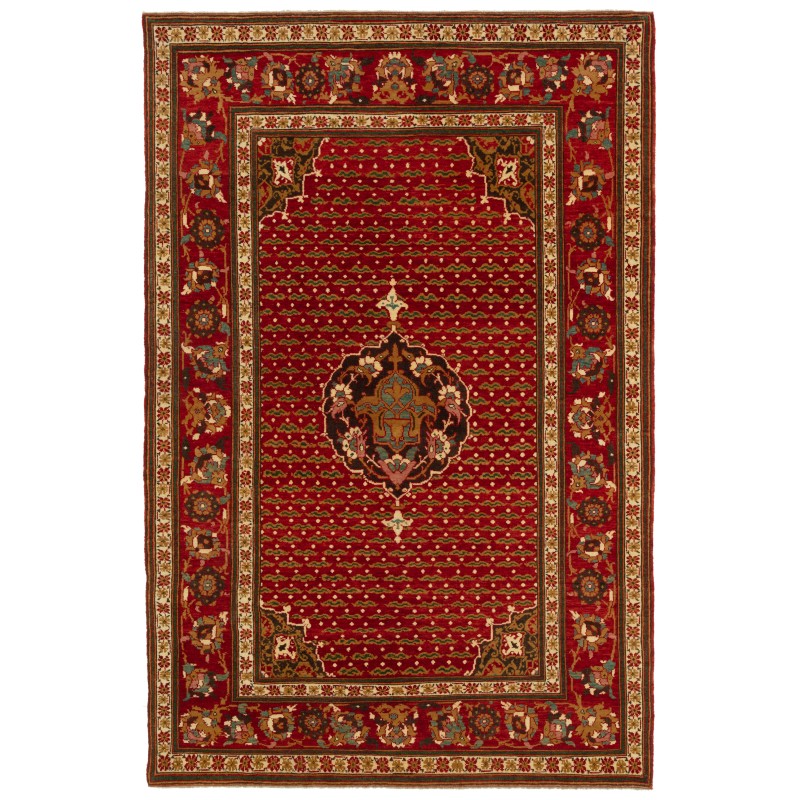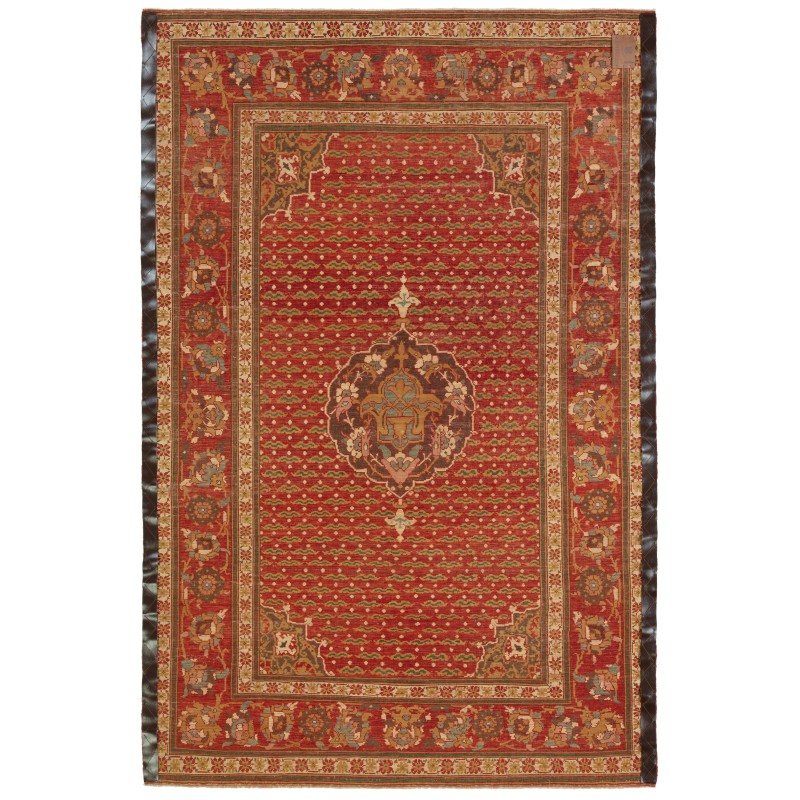



- Stock: In Stock
- Model: C50565
- サイズ: 212cm x 140cm
- Weight: 8.40kg
- SKU: ART565
トルコ宮廷製造の絨毯は、16世紀にオスマン帝国によって設立されたエジプトの工房で織られました。これらのカーペットは、イスタンブールで作成され、当時カイロに送られた紙の模様に基づいてエジプトで織られました。
絨毯の情報源は、McMullan, Joseph V.、およびErnst J. Grubeによる書籍「Islamic Carpets」(ニューヨーク:Near Eastern Art Research Center、1965)です。番号6、pp.36-37、図版。オスマン帝国による征服の直後(1517年)、エジプトではスタイルの変化が起こりました。イスタンブールの宮廷向けの工場の設立により、絨毯産業に力強い表現が見られました。カイロのオスマン帝国の絨毯は、以前の時期の絨毯と材料や色の範囲で一致し、パレットは黄色、白色、および他のいくつかの色の使用がより豊富になっただけです。ただし、カイロの基本的な3色に満足することもありました。それにもかかわらず、彼らの製造の連続性について疑問が投げかけられたことは、新しい絨毯がそれまで観察されていた装飾的な方向性を完全に放棄したという事実に基づいていました。時には自然主義的な植物が特異な方法で様式化され、豊富に配置され、トルコの壁タイルやブロケードで知られる形状で、無限に続くフィールドを完全に埋め尽くします。カーネーション、チューリップ、ヒヤシンス、リリー、牡丹などの花、優雅な曲線を描くランセット型の葉、豪華なヤシの木の葉、華やかな花束は、これらの絨毯の豊かな植物を構成します。境界線は、エレガントな角問題の解決策で目を楽しませます。同時に、警備ストライプではほとんど例外なく、小さなバラの花が一列に現れます。マムルークの伝統に従うものも見つかることはまれであり、一方で、デコレーションの革命は、まだ早い時期のグループに属するいくつかのサンプルで予告されています。純粋な民俗芸術では、このような根本的な変革は考えられませんが、工場の運営では、まったく新しいプログラムの導入は最小限の混乱で達成されることができます。この方向転換に伴い、異なる概念を持つ中央のメダリオンのアイデアがすでに使用されていたことは重要でした。
このウールの絨毯は、大きなフレームに繰り返される大きな花で飾られ、オスマン宮廷で人気のあった真珠のような斑点である「チンタマニ」が広範な面を装飾しています。中央には円形のメダリオンがあり、その上と下にフルール・ド・リスのようなモチーフが垂直軸を形成しています。中央のメダリオンと四つの角のクォーターメダリオンのデザインは、装飾的な本の装丁から派生したと考えられています。トルコのデザインを展示している一方、この絨毯の技法と材料は実際にはエジプトのものであり、16世紀のオスマン帝国の工房にエジプトの絨毯織りが存在していたことを反映しています。いわゆる「雷鳴と稲光」のシンボルがこの絨毯の全体のフィールドを覆っています。その背景には、1つの縁取りの中央メダリオンと4つの角ピースが現れます。境界線は特に興味深いです。主要なボーダーには、一方にバラ、もう一方にパルメットの花が配された双方の巻きスクロールがあります。この絨毯のデザインは解釈され、正確な色は当社のデザイナーによって選ばれました。
Turkish Court Manufactury Rugs were woven in the Egyptian workshops founded by Ottoman Empire in the 16th century. Those carpets were woven in Egypt, following the paper cartoons probably created in Istanbul and sent to Cairo at that time.
The source of carpet comes from the book by McMullan, Joseph V., and Ernst J. Grube. Islamic Carpets. New York: Near Eastern Art Research Center, 1965. no. 6, pp. 36–37, ill. Shortly after its conquest by the Osmanli Turks (1517), a change of style was set in Egypt which, due to the establishment of a manufactory working for the court in Istanbul, found a powerful expression in the carpet industry. The Cairene Ottoman carpets correspond with those of the previous period both in material and in color range, and the palette is extended only through the more plentiful use of yellow, white, and a few other tints; occasionally, however, they were inclined to be satisfied with the three Cairene basic colors. Nevertheless, if there have been doubts expressed regarding the continuity of their production, these were based entirely upon the fact that the new rugs completely renounced the decorative orientation which had been observed up to that point. Vegetation which at times is naturalistic, stylized in a peculiar manner, is deployed luxuriantly and, in forms that are known to us from Turkish wall tiles and brocades, quite fills the field in endless continuation, interrupted by a large or a small medallion, quadrants of which are often repeated in the corners. Carnations, tulips, hyacinths, lilies, peonies, and other flowers, together with gracefully sweeping lancet leaves, sumptuous palmettes, and delicate sprays of blossoms, constitute the rich flora of these carpets, whose borders charm the eye with their elegant solutions for the corner problem. At the same time, in the guard stripes almost invariably little rosette flowers appear all in a row. It is merely by way of exception that we will still find appropriations levied upon the Mamluk tradition, while, on the other hand, the coming revolution in decor is already heralded in a few specimens which we still count as belonging to the earlier group. In pure folk art, such a radical overturn would be quite inconceivable, but then in the operation of a manufactory, the introduction of a completely novel program can be accomplished with a minimum of confusion. With this change of orientation, it was significant that the idea of a governing medallion, even if with a different conception, had already been put to use.
This wool carpet presents a large border with repeating large blossoms, framing an extensive surface decorated with repeating chintamanis, the pearl-like spots that were popular in the Ottoman court. A circular medallion occupies the center, with a fleur-de-lis like motif at its top and bottom forming a vertical axis. The design of a central medallion and four corner quarter-medallions is thought to have originated in decorative book bindings. While displaying a Turkish design, the technique and materials of this carpet are actually Egyptian—reflecting the presence of Egyptian carpet weavers in sixteenth-century Ottoman workshops. A so-called ‘thunder-and-lightening’ symbol covers the entire field of this rug. Against this background appear a single, scalloped central medallion and four corner pieces. The borders are of special interest. The main border has a dual meandering scroll, one beset with rosettes, the other with palmette blossoms. The design of this carpet is interpreted and exact colors are chosen by our designers for this carpet.
私たちが作ったオリジナルの絨毯です。昔の作り方、染め方全て守って明日のアンティーク絨毯を眼材しています。 この絨毯作るのに全部で 8 色使っています。
- Imperial Red 415 (茜)
- Sunray Color 405 (ヘナ)
- Natural Wool Color 320 (羊そのままの色)
- Russian Green 418 (ヘナ - 藍)
- Brown 551 (茜 -Quercus infectoria)
- Natural Wool Color 37 (羊そのままの色)
- Yellow Green 419 (ヘナ - 藍)
- Melancholy 122 (トウダイグサ - 茜)
上の番号は私たちのカラーコードです。()の中は、主な草木染めの材料です。
